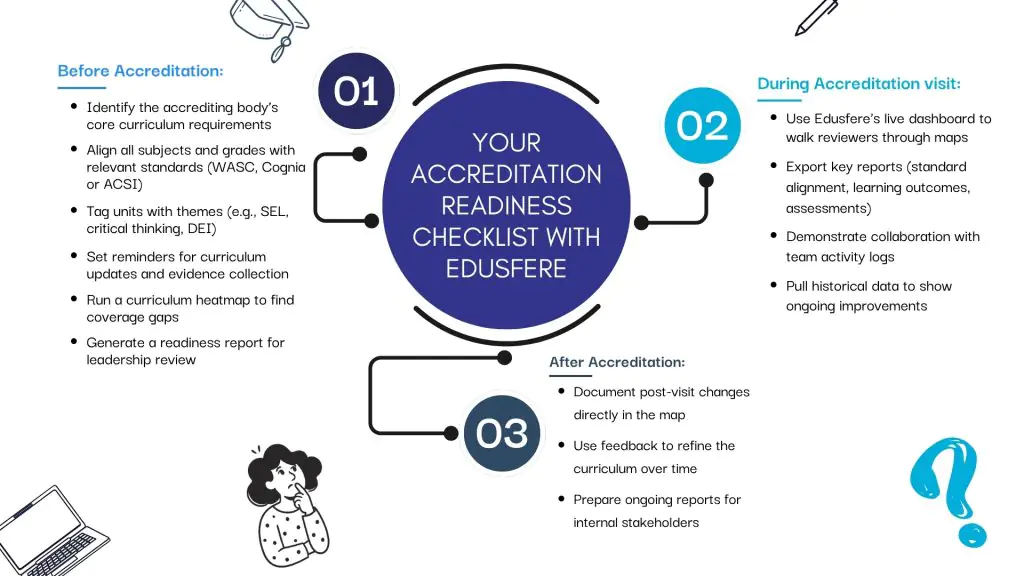Schedule a free demo to learn more
How Real-Time Curriculum Mapping Helps Schools Stay Ready for Accreditation Visits
6th May 2025

Stricter audits. Higher expectations. Lack of time to prepare.
If you’re part of a school leadership or curriculum planner, this scenario probably sounds all too familiar. In this accountability-driven educational environment, accreditation visits aren’t just formalities. They’re make-or-break moments for K-12 institutions.
Whether it’s WASC (Western Association of Schools and Colleges), ACSI (Association of Christian Schools International) or Cognia, accrediting bodies expect schools to demonstrate measurable progress, curriculum alignment and continuous improvement; and they want proof on demand. That’s where real-time Curriculum Mapping becomes more than just a planning tool. It becomes your audit-ready, compliance-driving, always-on source of truth.
Now, let us break down what accreditors really look for, why real-time curriculum mapping is a game-changer and how Edusfere helps schools stay accreditation-ready throughout the year.
What do WASC, Cognia and ACSI Accreditors really look for?
Accreditation bodies aren’t looking for polished presentations. What they want is evidence, in tandem with your school’s commitment to quality instruction, student outcomes and data-driven decision-making embedded in daily operations.
Here’s what they often assess:
- Curriculum alignment with academic standards (state or international)
- Consistency and continuity across grade levels and departments
- Documentation of instructional strategies and assessments
- Differentiation and personalization to meet diverse student needs
- Professional collaboration among educators
- Ongoing improvement processes tied to school-wide goals
Let’s take WASC (Western Association of Schools and Colleges), for example. Their criteria specifically entails clear articulation of curricular expectations and ongoing analysis of student achievement data. Similarly, Cognia emphasizes continuous improvement driven by systemic data use, while ACSI seeks evidence of a Biblically integrated curriculum with clearly defined learning outcomes.
Without a live curriculum map that centralizes this information, pulling it all together for accreditation can take weeks of scrambling.
Why Real-Time Curriculum Mapping is a Game-Changer?
Often spread across static spreadsheets or shared drives, traditional mapping can’t keep up with today’s pace of accountability. Real-time, software-based Curriculum Mapping offers a dynamic, transparent and collaborative approach that serves both instruction and compliance. Here’s how:
1. Instant access to Curriculum Evidence
Schools can provide on-the-spot evidence of standards alignment, lesson objectives, cross-curricular integration and assessment methods. All accessible in one click.
2. Live Collaboration and Version History
Teachers can co-create and update maps collaboratively ensuring alignment, reducing silos and reflecting real instructional practices. Accreditors love to see this kind of professional dialogue in action.
3. Alignment with Standards in Real-Time
Whether your school follows Common Core, NGSS, state-specific benchmarks or ACSI standards, real-time mapping allows for automated alignment tracking.
4. Tracking gaps and redundancies
Heatmaps and visual reports in platforms like Edusfere help identify over-taught or under-taught standards before they become a problem during reviews.
The Power of Live, Trackable Mapping Data
Let’s talk numbers. According to a 2024 survey by the Education Technology Industry Network (ETIN), 72% of K-12 administrators said curriculum mapping tools directly improved their accreditation readiness. More than half said these tools helped uncover instruction gaps that weren’t visible before.
Real-time curriculum management gives leadership a pulse on what’s actually being taught, not just what’s intended on paper. For accreditors, that distinction is everything.
Here are the key benefits of real-time Curriculum Management:
- Audit readiness, around the year
- Data-informed instructional planning
- Improved teacher onboarding and retention
- Enhanced student outcomes via aligned assessments
- Stronger collaboration and shared accountability
Key Accreditation-ready Features in Edusfere
Edusfere was built with accreditation cycles in mind. Here’s how it stands out from the crowd:
1. Accreditation Dashboard
A real-time dashboard that maps your school’s curriculum health against the required standard -WASC, Cognia or ACSI standards. Easily spot curriculum gaps, alignment issues and improvement opportunities.
2. Tagging and Filters for Evidence Collection
Tag curriculum components with evidence labels like ‘21st-century skills,’ ‘biblical integration,’ or ‘project-based learning.’ Export those tagged units instantly for audit documentation.
3. Automated Standards Alignment
Select your accrediting body’s preferred framework and Edusfere auto-maps your curriculum. Custom alignment features ensure you meet multi-accreditor needs.
4. Version Control and Audit Trail
Every change in your curriculum map is logged and time-stamped. Show accreditors how your school has evolved over time, transparently and credibly.
5. Built-in Reporting Tools
Generate PDF or live reports filtered by grade, subject, learning outcomes or teacher. Perfect for pre-audit check-ins or live accreditation walkthroughs.
6. Teacher Engagement Analytics
With Edusfere, you can easily track how frequently teachers update or review their maps. Use this data to support professional development or respond to accreditation questions about teacher involvement.
Your accreditation readiness checklist with Edusfere

Want to stay perpetually audit-ready? Here’s a step-by-step checklist followed by the schools using Edusfere at different stages of the accreditation process:
Before Accreditation:
- Identify the accrediting body’s core curriculum requirements
- Align all subjects and grades with relevant standards (WASC, Cognia or ACSI)
- Tag units with themes (e.g., SEL, critical thinking, DEI)
- Set reminders for curriculum updates and evidence collection
- Run a curriculum heatmap to find coverage gaps
- Generate a readiness report for leadership review
During accreditation visit:
- Use Edusfere’s live dashboard to walk reviewers through maps
- Export key reports (standard alignment, learning outcomes, assessments)
- Demonstrate collaboration with team activity logs
- Pull historical data to show ongoing improvements
After Accreditation:
- Document post-visit changes directly in the map
- Use feedback to refine curriculum over time
- Prepare ongoing reports for internal stakeholders
The Bottom Line: Accreditation isn’t a one-time event, it’s a culture
The schools that pass accreditation with flying colors aren’t the ones that sprint to the finish line. They’re the ones that make continuous improvement part of their daily routine and use smart tools to support that journey. Curriculum Mapping isn’t just about meeting requirements. It’s about building a school culture that’s transparent, responsive and accountable.
With Edusfere, you don’t prepare for accreditation. You stay ready for it.
Schedule a demo with Edusfere today and see how real-time curriculum mapping can transform your school’s readiness strategy.